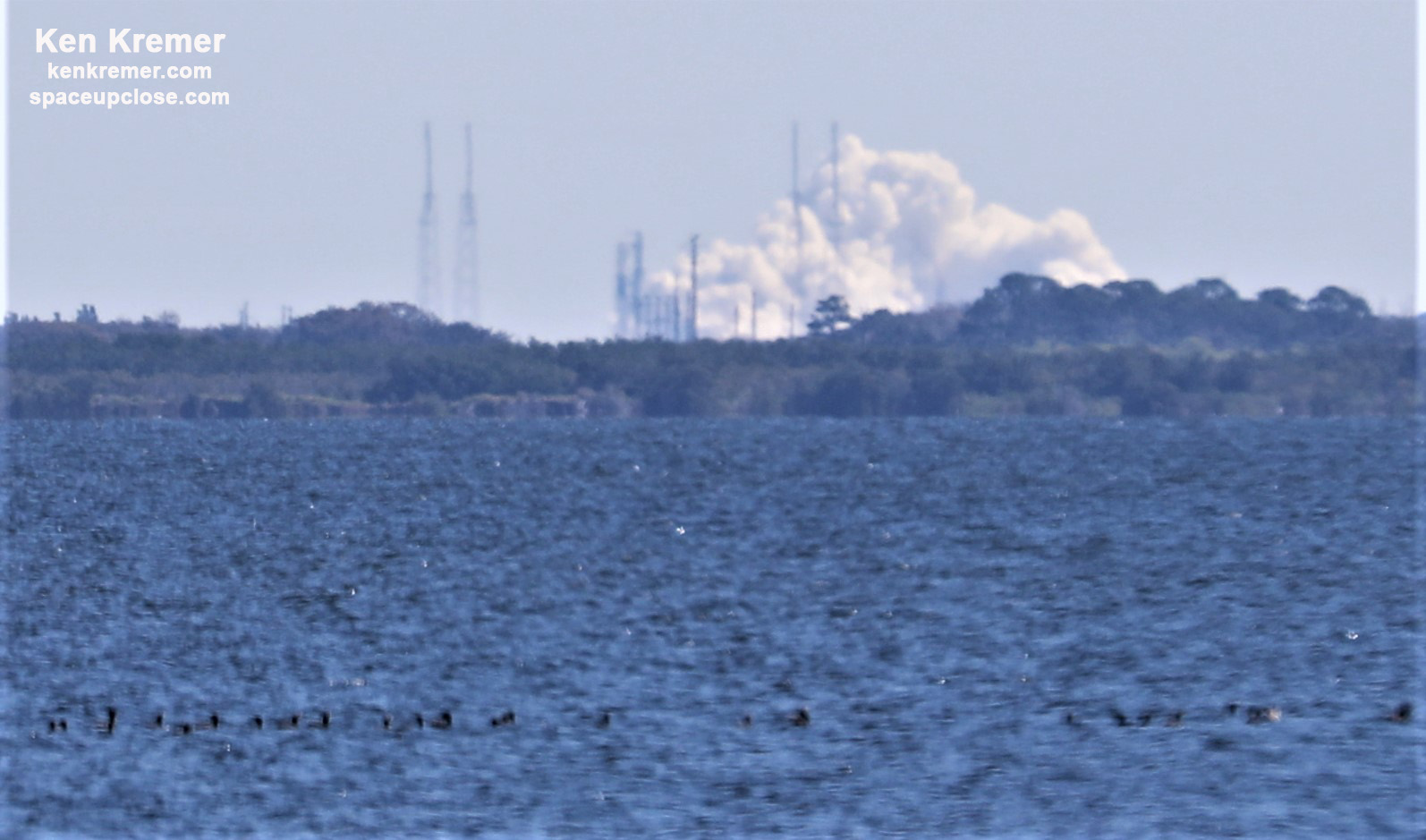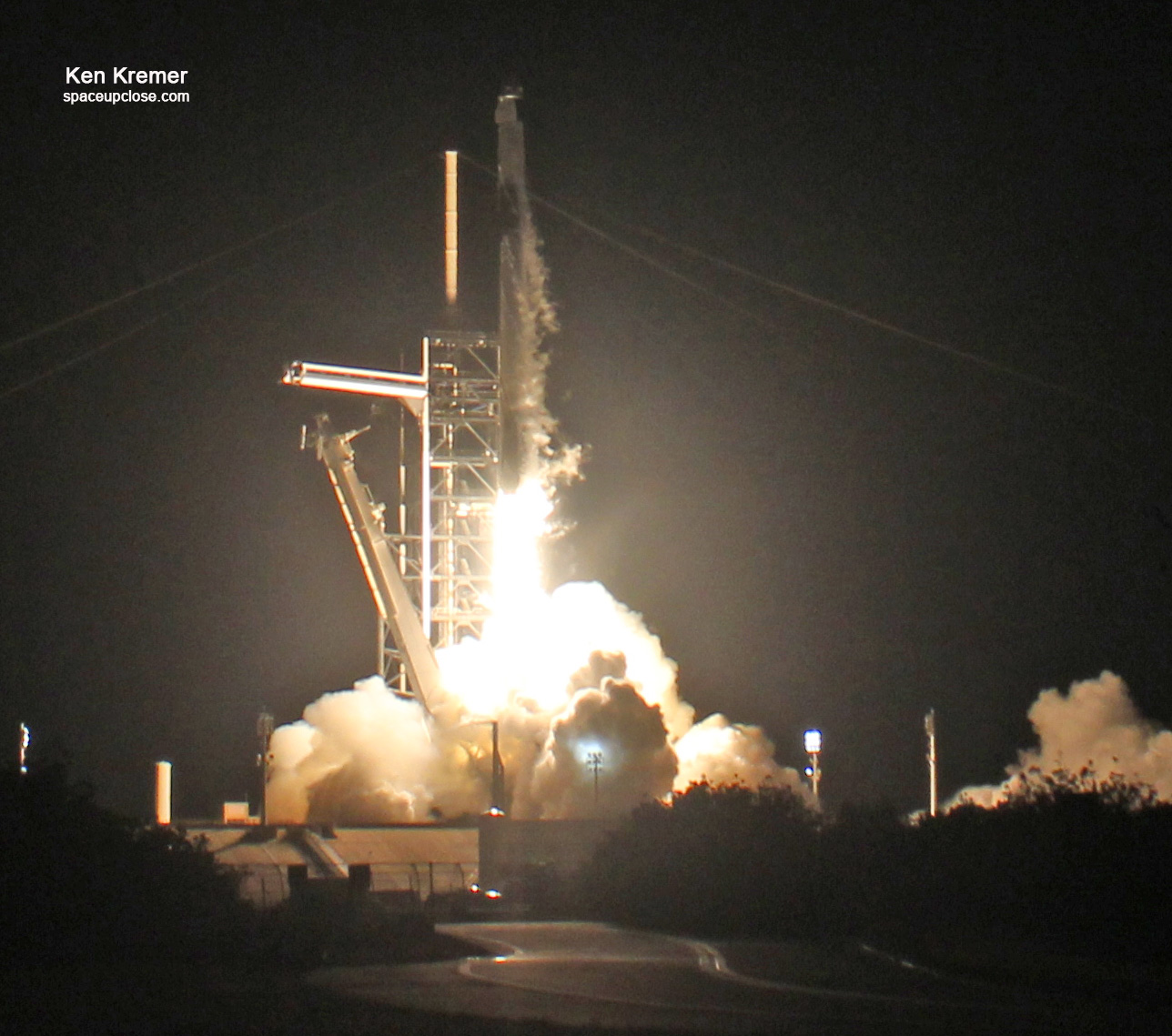
For SpaceUpClose.com & RocketSTEM
TITUSVILLE, FL- A successful static fire test today of a recycled Falcon 9 rocket puts SpaceX on course for a NASA contracted cargo launch on March 6 to the International Space Station (ISS) on what marks the final flight of the original version of the unpiloted Dragon resupply spaceship from the Florida Space Coast.
Under sunny skies right at the opening of the hour at 11:00 a.m. EST (1600 GMT) today Sunday, March 1, SpaceX engineers briefly ignited all 9 engines on their ‘flight-proven’ Falcon 9 first stage booster for a hold down static fire test at Space Launch Complex-40 generating 1.7 million pounds of thrust to affirm its readiness for launch later this week on Friday just before midnight March 6.
The SpaceX and NASA teams are now targeting liftoff of the Falcon 9 rocket carrying the Dragon CRS-20 cargo ship at 11:49 p.m. EST Friday (0449 GMT Saturday) from Space Launch Complex 40 at Cape Canaveral Air Force Station in Florida.
I watched the engine test Sunday morning from nearby in Titusville, Fl about a dozen miles away across the Indian River lagoon and observed the exhaust plume and vapor cloud emanating from the bottom of the booster.
The exhaust was easily visible and wafting overhead and dissipating quickly in the winds about 13 miles away.
Enjoy our Space UpClose wide and zoomed in eyewitness photos of the beautiful scene.

I heard the rockets rumble and come to life distinctly with about 1.7 million pounds of thrust roughly 40 to 50 seconds after the engine ignition.
The hot fire test seemed to go well and last about the normal time of some three seconds or so.
The vapor cloud swirled around and grew for perhaps 30 second before dissipating and disappearing in roughly a minute in the glaring late morning sunlight.
SpaceX confirmed a good outcome for the hotfire test by tweet about about twenty minutes later – thereby paving the path to launch of the Dragon cargo ship on the CRS-20 mission to the ISS.
“Falcon 9 static fire test complete — targeting March 6 launch from Pad 40 in Florida for Dragon’s twentieth resupply mission to the @Space_Station, the final flight of the first version of Dragon,” SpaceX tweeted.
SpaceX also informed that this cargo Dragon flew twice before on the CRS-10 and CRS-16 missions. And also released a photo of the Dragon showing the two logos for the two prior missions.
This is also the 3rd cargo Dragon to fly 3 missions – the maximum for which they are certified – on what counts as the final mission of the first generation Dragon vessel which has been flying to the ISS since 2012.
The Dragon 1 will be replaced by the more advanced Dragon 2 to be used for both cargo and crew flights for astronauts.
“The Dragon spacecraft supporting this mission previously flew in support of our tenth and sixteenth commercial resupply missions – this will be the third Dragon to fly on three missions.”
The Dragon spacecraft supporting this mission previously flew in support of our tenth and sixteenth commercial resupply missions – this will be the third Dragon to fly on three missions pic.twitter.com/AvqACtjoAo
— SpaceX (@SpaceX) March 1, 2020
SpaceX and NASA are now targeting liftoff of the Falcon 9 rocket launch with the unpiloted and recycled Dragon CRS-20 cargo ship from Space Launch Complex 40 at Cape Canaveral Air Force Station in Florida at 11:49 p.m. EST Friday (0449 GMT Saturday) – that coincides with approximately the moment that Earth’s rotation brings Cape Canaveral under the orbital plane of International Space Station.
The window is ‘instantaneous’ meaning any delay for weather or technical reason forces a minimum 1 day scrub.

The CRS-20 launch will be the 5th of the year for SpaceX and the first to the ISS.
The Falcon 9 first stage booster is also recycled having flown previously on the CRS-19 mission in Dec. 2019.
“The Falcon 9 booster supporting this mission previously flew in support of our most recent launch to the @space_station, CRS-19,” SpaceX tweeted.
The Falcon 9 booster supporting this mission previously flew in support of our most recent launch to the @space_station, CRS-19 pic.twitter.com/BaVqaZmWWx
— SpaceX (@SpaceX) March 1, 2020
It is expected that SpaceX will attempt to recover and soft land the Falcon 9 first stage back on land at Landing Zone-1 at Cape Canaveral about 8 minutes after liftoff.

Dragon CRS-20 marks SpaceX’s 20th contracted cargo mission to the space station under the original commercial resupply services (CRS) contract with NASA.
The Falcon 9 rocket comprising the first and second stages – but absent the Dragon cargo ship to keep it safe – was rolled out and raised vertical overnight.
See our raised Falcon 9 photos with a flock of birds floating and swirling overhead – as seen from Titusville.

Vigorous venting of liquid oxygen was observed in the final minutes of the countdown to the test as is normal.
The hold down static fire test is routinely carried by SpaceX to ensure all is ready with the rocket.
During the engine test all nine Merlin 1D first stage engines are briefly ignited for several seconds.
During Sunday’s hold down static fire test, the rocket’s first and second stages are fueled with liquid oxygen and RP-1 propellants just like an actual launch, and a simulated countdown was carried out to the point of a brief engine ignition lasting around 3 seconds or so.
With the pad in daylight and clear and slightly hazy conditions I was able to observe a large vapor cloud of exhaust emitted from the Falcon 9 first stage in the moments after ignition.
The hold down engine test with the erected Falcon 9 rocket involved the ignition of all nine Merlin 1D first stage engines generating some 1.7 million pounds of thrust at pad 40 while the two stage rocket was restrained on the pad – minus the Dragon payload.
The rocket will now be lowered horizontal and rolled back down the ramp and returned to the pad 40 hanger to attach the Dragon cargo spacecraft.
The prior CRS-19 resupply flight successfully flew in Dec 2019 from pad 40.
The two stage Falcon 9/Dragon rocket stands about 213-feet (65-meters) tall.
The 20-foot high, 12-foot-diameter Dragon CRS-19 vessel is jam packed with more than 5500 pounds (2500 kilograms) of science experiments, research hardware, space parts, food water, clothing and more supplies for the three person Expedition 62 crew.
The research gear will support dozens of the more than 250 science and research investigations that will occur during Expeditions 62 and 63 and beyond.
Experiments include the Generation of Cardiomyocytes from Induced Pluripotent Stem Cells (MVP Cell-03) experiment to study the generation of specialized heart muscle cells for use in research and clinical applications.
Also the Droplet Formation Study, which evaluates water droplet formation and water flow of Delta Faucet’s H2Okinetic showerhead technology. This research in microgravity could help improve the technology, creating better performance and improved user experience while conserving water and energy.
Another experiment is the Flow Chemistry Platform for Synthetic Reactions on ISS, which will study the effects of microgravity on chemical reactions, as a first step toward on-demand chemical synthesis on the space station.
In addition to bringing research to station, the Dragon’s unpressurized trunk will transport the European Space Agency’s (ESA) Bartolomeo, a new commercial research platform set to be installed on the exterior of the orbiting orbiting laboratory’s Columbus module.
SpaceX was awarded an approximately $3.1 Billion contract from NASA to launch 20 Dragon cargo missions to the orbiting outpost through 2019 under the Commercial Resupply Services-1 (CRS-1) agreement that was amended in 2015 and increased from an original value of $1.6 Billion.
NASA also awarded a CRS contract to Northrop Grumman that has likewise been increased.
Northrop Grumman most recently launched the NG-12 resupply mission earlier this month. See our articles and photos.
Both companies also won new cargo mission contracts under the Commercial Resupply Services-2 (CRS-2) agreement awarded last year.
My static fire photos were also featured at WKMG CBS 6 TV News Orlando

Watch Ken’s continuing reports onsite for live reporting of SpaceX CRS-20 as well as upcoming and recent ULA and SpaceX launches including Crew and Cargo Dragon, Solar Orbiter, In-Flight Abort and Starlink at the Kennedy Space Center and Cape Canaveral Air Force Station.
Stay tuned here for Ken’s continuing Earth and Planetary science and human spaceflight news: www.kenkremer.com –www.spaceupclose.com – twitter @ken_kremer – email: ken at kenkremer.com
Dr. Kremer is a research scientist and journalist based in the KSC area, active in outreach and interviewed regularly on TV and radio about space topics.
………….
Ken’s photos are for sale and he is available for lectures and outreach events
Ken has created hundreds of widely published Mars rover mosaics and lectures also about NASA’s Mars rovers
Ken’s upcoming outreach events:
Mar 4-5: 7 PM, Quality Inn Kennedy Space Center, Titusville, FL. “SpaceX CRS-20, IFA and Starlink launch, ULA Solar Orbiter launch.” Free. In hotel lobby. Photos for sale





